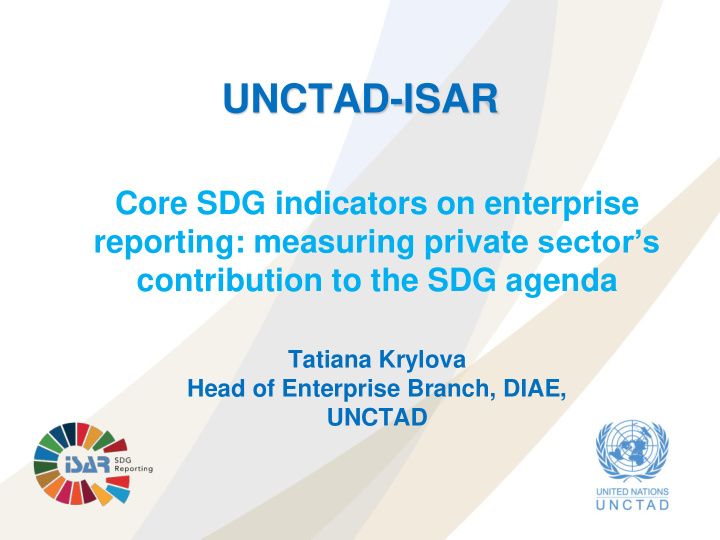



UNCTAD-ISAR Core SDG indicators on enterprise reporting: measuring private sector’s contribution to the SDG agenda Tatiana Krylova Head of Enterprise Branch, DIAE, UNCTAD
Core SDG indicators on enterprise reporting • In 2016 UNCTAD through its ISAR standing expert group on enterprise accounting and reporting launched its work on baseline core SDG indicators with a view to improve comparability of sustainability/SDG reporting and its alignment with the SDG macro indicators. • It resulted in developing Guidance on core SDG indicators (GCI) to assist member States to assess the private sector contribution to the SDG implementation and to enable them to report on SDG 12.6. and indicator 12.6.1 in a consistent and comparable manner. • The GCI also supports UNCTAD's work on developing the metadata guidance for the SDG 12.6.1 "Number of companies publishing sustainability reports" , as a co-custodian with UN Environment.
UNCTAD Approach: From SDGs to Core Indicators for Companies • Logical framework: 17 Sustainable Framework of SDG Enterprise indicators Development Goals targets and indicators Alignment with macro-level • Example: of statistical indicators 7.2.1: Renewable B.5.1: Renewable SDG 7 : Affordable and energy share in the total energy as a percentage Clean Energy final energy of total energy consumption consumption during the reporting period
Economic area Socia area - Revenue - Proportion of women in managerial positions - Value added (gross value added, GVA) - Average hours of training per year per employee - Net value added (NVA) - Expenditure on employee training per year/employee - Taxes and other payments to the Government - Employee wages and benefits as a proportion of revenue, with breakdown by employment type and gender - Green investment - Community investment - Expenditures on employee health and safety as a proportion of revenue - Total expenditures on research and development - Frequency/incident rates of occupational injuries - Percentage of employees covered by collective agreements - Percentage of local procurement GCI core indicators Environmental area - Water recycling and reuse Institutional area - Water use efficiency - N. of board meetings and attendance rate - Water stress - N. and percentage of female board members - Reduction of waste generation - Board members by age range - Waste reused, re-manufactured and recycled - N. of meetings of audit committee and attendance rate - Hazardous waste - Total compensation per board member - Greenhouse gas emissions scope 1 - Amount of fines paid or payable due to settlements - Greenhouse gas emissions scope 2 - Average n. of hours of training on anti-corruption issues, per year per employee - Renewable energy etc.
Work in progress Developing case studies by pilot-testing the core indicators at the country level (i.e. cases of Novonordinsk and statistic Denmark has been already presented at ISAR35; case studies in Russia, Ukraine, Guatemala, Columbia, Kenya etc. are in progress); Cooperation with UN Environment and Task Force on finalization and pilot testing of the 12.6.1 metadata methodology, application for reclassification of indicators to Tier II by the end of 2019; UN Development Account project on building capacity on the SDG reporting by companies in selected member States; Further discussions at the ISAR 36th session in 2019; which will include second edition of ISAR Honors following a successful launch of the initiative at ISAR 35 in 2018 (https://isar.unctad.org)
ISAR Honours Call 2019 • Objective is to raise awareness and facilitate dissemination of national and international best practices on sustainability and SDG reporting by companies • Nominations for the ISAR Honours can be submitted by an extended deadline of 30 June 2019 SUBMIT YOU APPLICATION!
https://isar.unctad.org
Recommend
More recommend